RME Cables & Energy
The laboratory's work on the behavior and durability of cables for RME applications aims to better understand the behavior of the studied cables, which may contain different materials and have a complex internal structure. It also aims to better define the durability of the studied cables, particularly with regards to fatigue or environmental stresses. Two categories of cables are currently being studied:
- Metallic or synthetic mooring cables
- Energy transmission cables.

PIA ADEME Project : OCEAGEN – Lot 2 Components of Mooring system
Oceagen is a research and development project supported by ADEME under the Investments for the Future program, which pursues two main objectives:
· Validate, under real conditions, the hydrodynamic behavior of the Ideol offshore wind turbine floater
· Qualify new components for the anchoring system Indeed, offshore platforms are held by anchoring systems composed of cables and chains attached to the seabed.
The SMC laboratory contributes to this project as part of the qualification of these permanent anchoring cables. The modularity and workspace offered by the cable fatigue testing bench has allowed for the best possible characterization of the dynamic behavior of offshore platform anchoring cables using an experimental device. The objective was to adapt the actual operating conditions of these cables subjected to fatigue loading on the SMC laboratory's fatigue testing bench. The fatigue tests consisted of stressing the floater anchoring cable of the offshore wind turbine in such a way as to vary its radius of curvature (simulating the stresses mainly due to waves), combining tensile and flexural forces representative of other stresses such as currents and winds. The real-time detection and location system for defects, CASSC, developed in the laboratory was used during the tests. The results obtained in terms of duration curve were compared to existing standards.
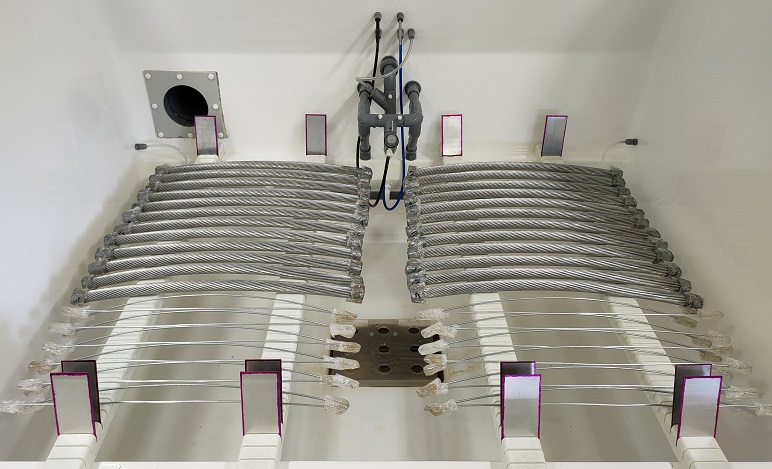
Accelerated corrosion tests and damage evaluation on aluminum-steel power transmission conductors
The majority of overhead power lines have been in service for several decades and are subject to several degradation phenomena. ACSR conductors, the most commonly used, are subject to several weathering phenomena impacting their electrical and mechanical properties. One well-known degradation phenomenon on metallic structures is corrosion degradation, the consequences of which are poorly studied on power lines.
The main objective of the thesis was to quantify the influence of the geometric structure of ACSR wires and cables, as well as the effect of lubrication on NaCl-type corrosion. Therefore, the first task was to carry out accelerated corrosion tests, in which several samples of electrical conductors were corroded according to specific and controlled climatic parameters. On the other hand, a microscopic and metallographic analysis of the corroded samples was performed, studying the impact of the corrosion suffered by these samples on their mechanical parameters using tension, torsion and fatigue tests. The results from the mechanical tests were correlated with the metallographic observations in order to link the damage mechanisms occurring on the wires with the mechanical property losses observed on the wires.
This thesis was carried out in collaboration with the University of Sherbrooke.
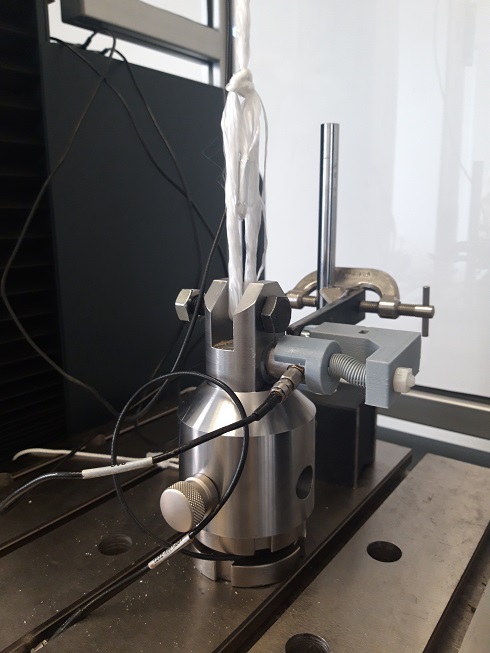
ANR FEM Monamoor Project: Monitoring of Polyamide Mooring Lines (2020-2024)
Well established in Europe, offshore wind power has a global potential that could reach over 100 GW by 2030. Floating wind turbines are estimated to represent 10% of the market, exploiting offshore sites where the available wind potential is up to four times higher than for fixed turbines. Compared to the foundations of a fixed wind turbine, a mooring system is easier to install and adapts more easily to the geological characteristics of the installation site.
Floating offshore wind power, whose mooring system is an essential element, can quickly become a competitive alternative. Current floating wind sites are located in shallow to moderate depth waters, where a standard catenary mooring is not suitable. A semi-rigid mooring composed of synthetic lines ensures more effective restoring forces and dynamic damping. With a reduced ground footprint of up to two times, the polyamide cable is a promising solution.
The Monamoor project aims at developing modeling tools for the mechanical behavior of nylon fiber lines and appropriate long-term monitoring instruments, based on a deep understanding of material degradation mechanisms. The SMC laboratory will be involved in the evaluation of acoustic emission monitoring of these cables.
Project website: https://www.france-energies-marines.org/R-D/Projets-en-cours/MONAMOOR
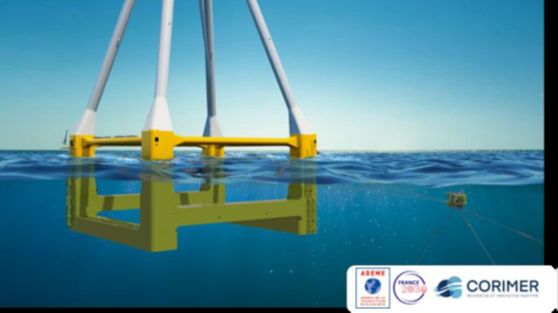
Project AMI CORIMER-Ademe: HT-20MW
The HT-20MW project aims to deploy an electrical connection hub (66 kV voltage) at sea and to study an application for a 20 MW wind turbine. It is mainly intended for future floating wind turbines but also for the power supply and anchoring of ships at sea. The project includes the mechanical and electrical qualification of the electrical cable and anchor line subsystems within the partner laboratories, as well as the design of a 20 MW floating wind turbine.
The SMC Laboratory is mainly involved in the following subjects:
• Identification of failure modes of synthetic lines and dynamic cables
• Fatigue tests of dynamic cables and mechanical tests of synthetic anchor lines
• Qualification of monitoring solutions for these cables
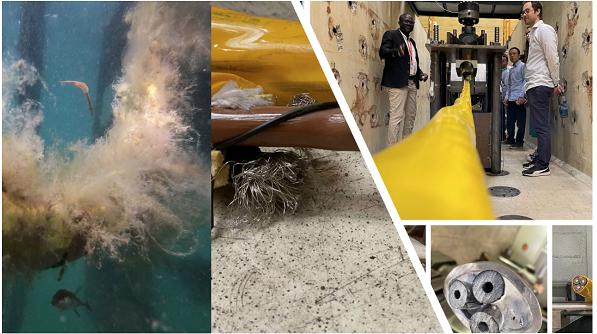
Project Seasnake + (EU)
The main objective of SEASNAKE+ is to scale up and demonstrate (TRL 6-7) the dynamic medium voltage cable (dMVC) with an improved lifespan by employing: easy-to-clean paint; an in-line, in-situ paint application chamber; an in-situ cleaning robot; and a new, scalable protection and monitoring system for the cable. The SEASNAKE+ dMVC will first be validated at a small scale in nearshore conditions at two different sites (the Swedish west coast and the Mediterranean Sea). Once the full-scale prototypes are ready, validation will take place in a real ocean environment in the Mediterranean Sea.
The objectives and activities of SEASNAKE+ build upon the lessons learned and the proof-of-concept (TRL 4) achieved during the previous SEASNAKE (OCEANERANET COFUND) project, which developed a new lightweight (non-armored) and flexible cable. The SMC laboratory at Gustave Eiffel University is responsible for validating the fiber optic cable monitoring system proposed by the project partners.
SEASNAKE+ expands these efforts at a European level, addressing key gaps and leveraging opportunities identified during the earlier projects. This includes scaling up production, integrating the protection system application into the manufacturing process, and implementing new, sophisticated, and innovative methods to measure cable movement (shape sensing) and failure modes through an integrated fiber optic solution.
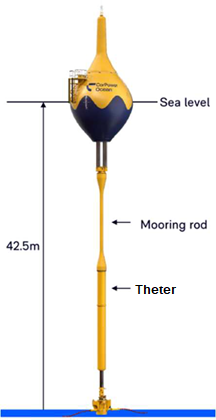
Project Smartmooring (EU)
The Smartmooring project aims to revolutionize mooring systems for marine energy devices by integrating fiber optic sensors capable of providing real-time data on the shape, load, vibrations, and temperature of mooring components. Running from December 2023 to November 2025, the project tackles key technological challenges, such as embedding sensors into complex components and optimizing performance through advanced modeling. Its primary goal is to advance these innovations from TRL 2 to TRL 5, demonstrating their added value in two specific applications: a mooring rod for CorPower Ocean's wave energy converters and a carbon cable for Minesto's tidal energy converters. Through this international collaboration, including academic and industrial partners such as RISE, Gustave Eiffel University, and the Polytechnic University of Valencia, Smartmooring aims to enhance the reliability and energy efficiency of marine devices while reducing operational and environmental costs.